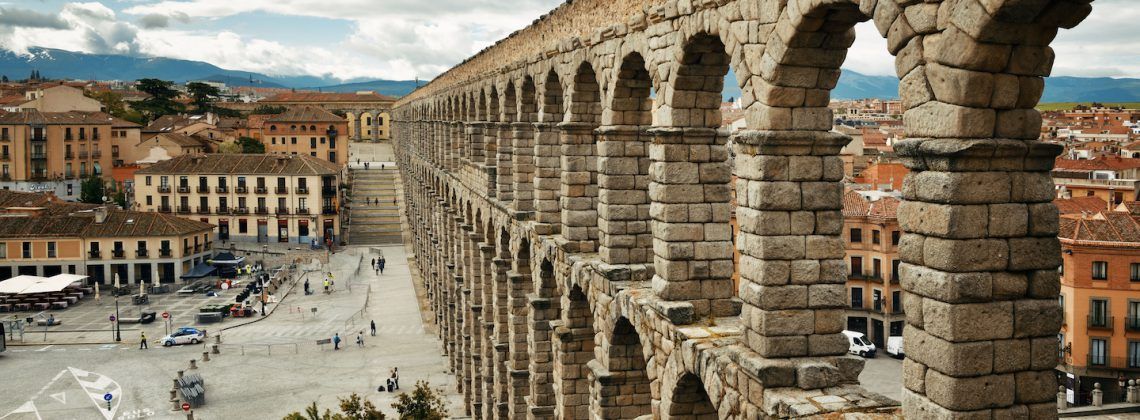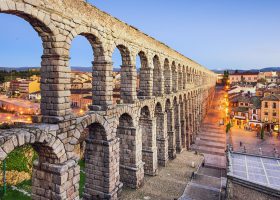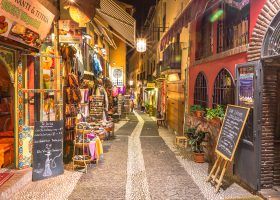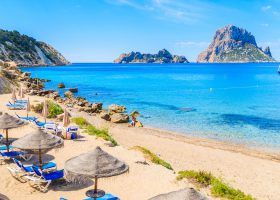Spain is a country renowned for Muslim Western architecture like the Alhambra. But the history of Spain goes beyond mesmerizing fortresses and palaces. Think you know all about the history of Spain? Think again. Spain boasts a history as dramatic and dynamic as a Pedro Almodovar film! Check out this brief history of Spain written by a historian.
A Short History Of Spain From Prehistory To The Present
Walking around the busy, modern Spanish cities, it can be difficult to find traces of Spain’s richly layered history. Of course, you will be able to spot the countless churches and fortresses spread across the country. Sadly, though, there is little information to help explain the history behind many of these sites and the events they’ve witnessed over the centuries.
But fear not! This article offers a primer in the history of this celebrated European country. Spain is truly an open-air museum. You just need to know what to look for. Here we’ll discover the moments, places, and people to help us understand the rich history of Spain across the ages. So, let’s explore the basics of its history.
Spain: A Brief Historical Sketch
Our story begins way back in Prehistoric times. We know the earliest humans lived in Spain as far as 1.2 million years ago. In the coming centuries, Spain experienced various developments common in the Mediterranean world, such as Roman rule. Scholar Juana Sáez Juárez reminds us of the amazing skeletal discoveries from Atapuerca, setting human occupation much earlier than expected.
Julius Caesar wrote countless accounts of the importance of the Spanish provinces for Rome. But after the Romans left, the history of Spain continued. Dr. Daniel Gómez Aragonés advocates for the importance of the legacy of the germanic tribes in Spain in the early middle ages.
Centuries later, Spain will experience the rule of Muslim conquerors, different Christian kingdoms, the Habsbourg empire, and the Bourbon dynasty of France. But the history of modern Spain reflects a country suffering because of poor governments and war, particularly in the last 2 centuries.
And with that intro, here are 12 main historical periods to help us better understand the history of Spain.
Prehistoric Spain (1.2 million years go – 6thcentury BCE)
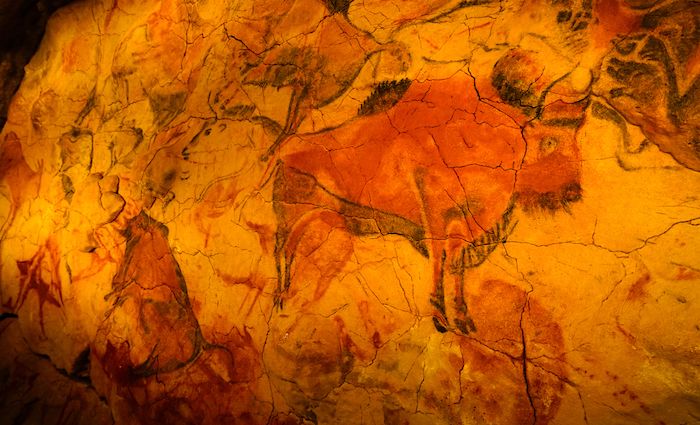
Homo Heidelbergensis | Altamira | Megalithic Culture
Spain is home to some of the most important prehistoric discoveries in Europe. Atapuerca, in Burgos, contains some of the earliest evidence of hominin occupation in the West as the archeological team led by Eudald Carbonell. In fact, La Sima de Los Huesos, a pit with over 5500 human remains demonstrates that the homo heidelbergensis inhabited the Iberia Peninsula in the Middle Pleistocene.
Moreover, the archeological record shows that Neanderthals live in Spain for a long time. One of the most important archaeological discoveries regarding Neanderthal is in Gibraltar in Forbes’ Quarry. Eudald Carbonell proposes that Neanderthal coexisted with Homo Sapiens when they arrived at the Iberian peninsula in the later stages of the Paleolithic.
However, these early Homo Sapiens left Spain with an enormous gift. Spain is one of the most important places in the world because of its abundance of Paleolithic cave paintings. For example, the cave of Altamira (Cantabria) contains world-famous depictions of bison, which are some of the earliest artworks in history.
Furthermore, the first agrarian cultures arrived in Andalucia in the 6th millennium BCE during the Neolithic. Their settlements led to the development of megalithic culture. Good examples of these are the Dolmenes de Antequera, near Malaga. This is a Unesco Heritage Site like Altamira and Atapuerca.
These dolmens are amongst the earliest ceremonial monuments created by humans in Western Europe. These incredible advances made Spain a rich area of Europe during the Copper and Bronze Ages. By the Iron Age, the Phoenicians established their colonies in the Levant.
Eventually, the city of Carthage took over the Phoenician colonies creating their own empire. And, it was due to the power creep fight between Carthage and Rome that a key moment in Spanish history took place: the Romanisation.
Hispania (2nd century BCE – 5th century CE)
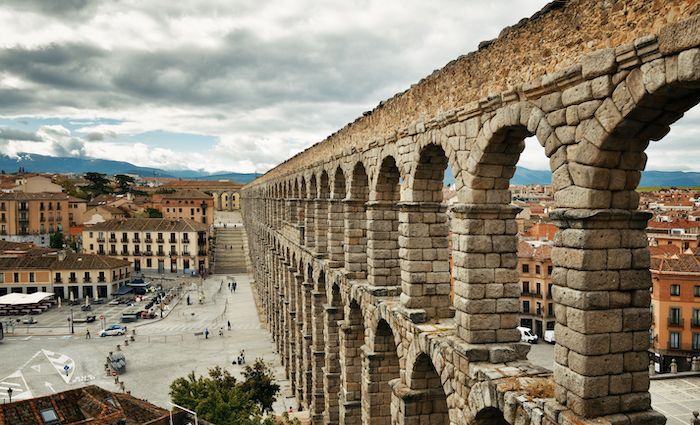
Punic Wars | Romanisation | Fall of Rome
The Romans arrived in the Iberian Peninsula due to the Punic Wars against Carthage. According to historian John Francis Lazenby, during the Second Punic War (218-202 BCE), Hannibal amassed troops from Iberia to march over Rome. So, Rome retaliated by attacking Nova Carthago (modern-day Cartagena in Murcia). This was the most important Carthaginian settlement in Spain and how the conquest of Spain began in the 2nd century BCE.
However, Rome would not conquer Spain in full until the year 14 CE. In fact, scholar Angel Ocejo Herrero confirms that the Cantabrian Wars were such an issue for the Romans that Augustus himself came to Spain to end this conflict and claim all of Hispania in the name of the Roman Empire.
Hispania provided Rome with two of the best known Roman cultural items: olive oil and wine. Furthermore, Hispania even birthed some of the greatest Roman Emperors of all times: Trajan, Hadrian, and Theodosius I. The Roman Aqueduct of Segovia, one of the best-preserved Roman aqueducts in the world, shows the impact of the Roman worlds in Spain and vice-versa. However, the might of Rome would eventually decline, leading to a new period of Spanish history in the 5th century: the Germanic invasions.
Visigoths & Al-Andalus (5th century CE – 711 CE)
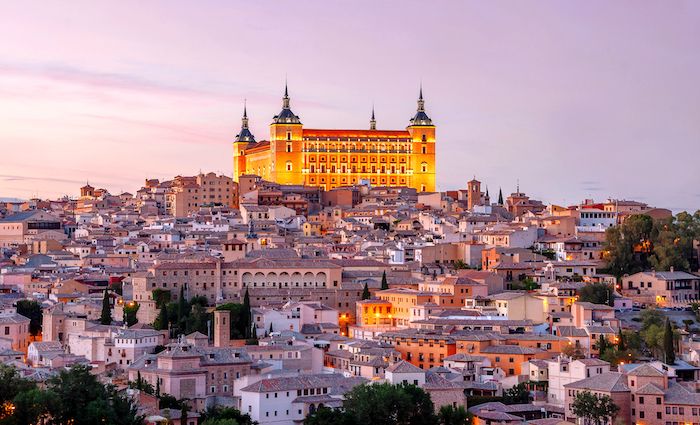
Germanic Invasions | Feuds | Conquest of 711
After the fall of Rome in 476 CE, different Germanic tribes came to Spain including, Suebi, Vandals, Alans, and Visigoths. The Visigoths became the new rulers of Spain even though they were a minority within their own kingdom, states Dr. Daniel Gómez Aragonés. This caused dynastic issues that lead to their downfall. Their succession system was an elective monarchy.
This caused endless feuds and coups, leaving Spain open to external threats. Finally, in 711 after the death of King Witiza, there was a small civil war between different Visigothic factions. And then that the Muslim forces deployed by the Umayyad Caliphate in Morocco crossed over the Strait of Gibraltar to Spain.
According to Roger Collins, the forces led by Tariq ibn Ziyad found little resistance, allowing them to advance quickly throughout the Iberian Peninsula. By 718, the vast majority of Spain was under Muslim rule. The only part of the country that would remain unconquered was the north under the small kingdom of Asturias. This was the last Christian bastion in Spain and will serve as the platform to launch a campaign that lasted 700 years: La Reconquista
La Reconquista (711 – 1492)
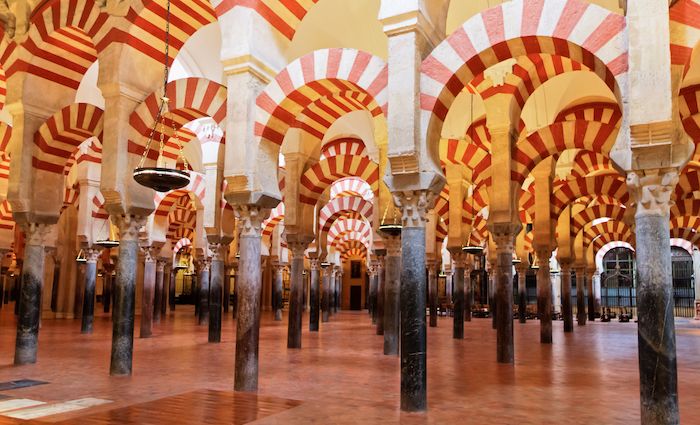
Cordoba | Taifa Kingdoms| Fall of Granada
Al-Andalus was a golden age for Spain. During this period, Cordoba (Andalucia) became one of the most important cities in the world. The Mosque-Cathedral of Cordoba still stands today as a unique building that represents the power of Al-Andalus and the mix of cultures that has always been so important for the development of Spanish society. Scholar Rodriguez Jarbel supports this argument.
But the Muslim world had its own problems. And in less than 2 centuries the Umayyad Caliphate of Cordoba dissolved into smaller kingdoms and fiefdoms called taifas. The infighting and political quarrels between the different Muslim factions would allow the Christian kings to exercise pressure and start reconquering Spain. However, it would take the Christian kingdom over 3 more centuries to conquer the remaining half of the country due to their own political intrigues and turmoil.
However, during this period the Muslim kingdom of Granada would provide Spain with one of its most iconic monuments: La Alhambra. But, historian Teofilo F. Ruiz expalins that Granada was only operating in bought time as a tributary state to the kingdom of Castile. Castile, along with Aragon, was the main political power in Christian Spain.
In the 15th century, their monarchs Isabel, and Fernando, got married and unified their kingdoms. So they turned to their only remaining enemy: the Muslim south. Finally, in 1492, their troops marched over Granada and conquered it. Spain was whole again.
Want to ensure you get inside the Alhambra? Book a tour with admissions included — not to mention, this massive complex is best visited with a guide!
America & the Spanish Empire (1492 – 1556)
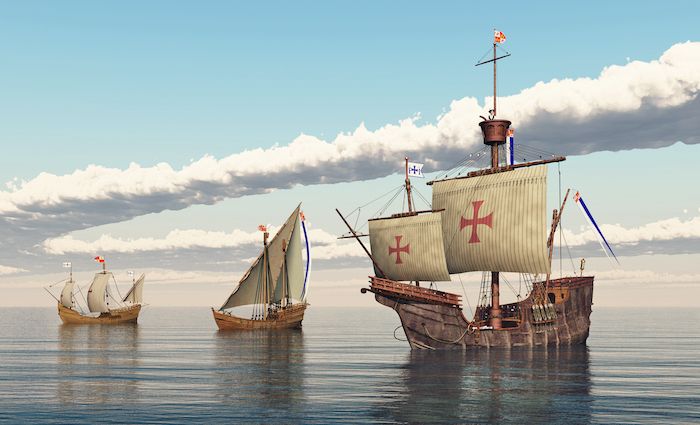
1492: America | Charles V | A Vast Empire
Isabel and Fernando did not only achieve the unification of their lands in 1492, but they also funded Colombus’ expedition across the Atlantic. With the discovery of America and its conquest, Spain became the leading power in Europe. Silver and gold from America contributed to Spanish prowess and a healthy economy. With the ascension of Charles I to power in 1516, Spain turned from kingdom to empire.
Martyn Rady explains that Charles was not only heir to the Spanish throne: he was also heir to Flanders, Burgundy, and the Holy Roman Empire. With all these titles, he created the Spanish empire. However, Charles’ success had considerable drawbacks. He was at war with France over the Italian territories that belonged to Spain. Besides, he was trying to stop the Ottoman Empire on the Eastern front of his empire.
This meant he spent a lot of time away from Spain, which caused great resent according to historian Geoffrey Parker. So did his attempt to centralise Spain along with his vast empire. Unfortunately, Charles spent his entire life constantly traveling, putting fires out throughout the empire. Completely burnt out, he abdicated in 1556, leaving his son Phillip II in charge of an ever-growing list of problems to take care of.
The Reign of Phillip II (1556 – 1598)
Division of the Empire | Flanders | Bankrupcy
Phillip did not succeed Charles as Holy Roman Emperor. Instead, he divided the empire with his uncle, which reduced his problems somewhat. According to scholar Henry Kamen, Phillip II focussed on Spain and cultivated an austere and efficient government. Phillip is known as the paper king because he left a paper trail for almost everything. Unfortunately, Phillip inherited all of his father’s debts: the costs of war and trying to keep the empire afloat.
Then, the Spanish economy begins to sink. Phillip managed to defeat the French and reach peace agreements with the Muslim factions. However, Flanders becomes the contested territory for Western Europe. In fact, it is because of Flanders, and an ill-fated marriage with Mary of England, that Spain and England become enemies. The defeat of the Spanish Armada immortalises this conflict.
Phillip would also struggle with the New World colonies due to poor communications across the empire according to Geoffrey Parker. The king of Spain never set foot on the colonies across the Atlantic, so he had to rely on others to do his bidding. This caused a massive issue with corruption that slowly chipped away at the poorly established hierarchies in the colonies leading to social and political unrest. Along with several plagues that damaged Spain during the 16th and 17th century, the great Spanish Empire began to crumble.
Golden Age & Decline (16 & 17th centuries)
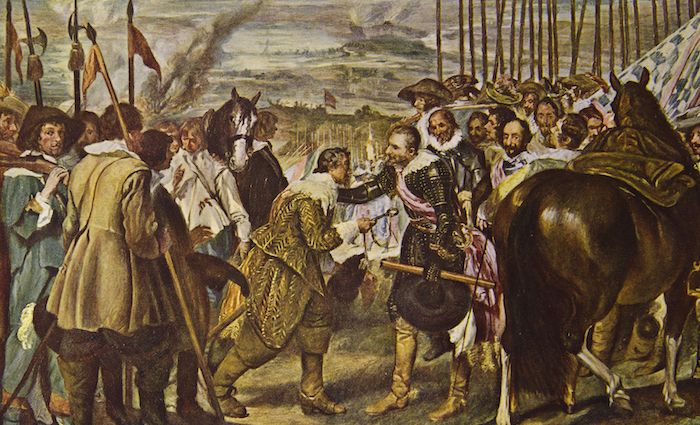
Art & Literature | Bad Kings | Decline
The 15th and 16th centuries were the political Golden Age of Spain. But the arts flourished in the late stages of the 16th and 17th centuries. Artists such as El Greco and Velazquez will produce their remarkable pieces under the patronage of the Spanish court. These are the years of Spanish baroque, Cervantes and Don Quijote de la Mancha, and the consolidation of Spanish theatre from Lope the Vega.
Unfortunately, the end of Phillip II’s reign would see the last competent king Spain would have for centuries. His successors were generous patrons of the arts, but they lost control over the empire. In fact, Phillip III and IV were so bad governors, they created a new political charge to rule the country for them: the “valido”. The Archduke of Olivares, immortalized in the Spanish novel series by Arturo Perez Reverte: El Capitan Alatriste, ruled the country with an iron fist.
His policies caused discontent and unrest, particularly in Andalucia and Cataluña according to Graham Darby. By the year 1700, Spain was in ruins, politically, socially, and financially. And this is the moment when the Hapsburgs lose control over Spain.
Dynastic Change (1700 – 1808)
Charles II | The Bourbon | Absolutism
Thanks to years of incest and inbreeding, the Spanish monarchy landed Charles II El Hechizado (the Bewitched) as sovereign. According to scholar Sylvia Mitchell, Charles was not only physically and mentally disabled but also infertile. Spain needed a change in leadership. The Bourbon then became kings of Spain as Charles II died without heirs.
Phillip of Anjou becomes king of Spain after winning the War of Spanish Succession. However, the Spanish did not appreciate having a French king in power, according to Henry Kamen. Besides, it did not help that Phillip promoted centralization and stripped of their power and special rights to many provinces across the Spanish territory. From this moment on, Spain would become a follower of French absolutism.
Furthermore, this was a more prosperous time from an economic viewpoint, but Philip lost Spanish territories in different conflicts. Ultimately, Spain’s alliance with France throughout the 18th century against England had severe consequences for the future of Spain.
The Peninsula War (1808 – 1833)
Napoleon | La Pepa | Restoration of the Monarchy
In 1808 under the pretense of wanting to gain access to Portugal, the French troops of Napoleon I invaded Spain, despite the alliance between the 2 countries. King Ferdinand VII was removed from the throne. Instead, Joseph Bonaparte, brother of Napoleon, became King of Spain for 14 years. The French occupation of Spain lead to a series of revolts: Dos de Mayo Uprising (1808), which the contemporary artist Francisco de Goya captures in his pieces of the same name with great dramatism.
After much struggle and hard fight, the freedom fighters among the Spanish people gathered in Cadiz in 1810 to reinstate the Spanish parliament, representing the occupied state and the leftovers of the empire. Through these sessions, they developed the first-ever Spanish constitution of 1812 or commonly called La Pepa. This was one of the first documents of its kind in the world.
Thanks to a turn in the front against Russia in 1812, Napoleon recalled many French troops from Spain, allowing the Spanish forces to seize back power with the help of Britain and Portugal. In 1814, Ferdinand VII became king again but refused to acknowledge the constitution and re-established absolute rule. Spain fought hard and regained little else beyond nominal independence. By the end of his reign, all that was left of the American colonies were Cuba and Puerto Rico.
19th Century Turmoil (1833 – 1898)

Isabel II | Alfonso XII | Generacion del 98
After the death of Ferdinand VII in 1833, his daughter Isabel II became queen. This was the beginning of a series of civil wars (Las Guerras Carlistas) for the control of Spain. The 19th century would not see a single moment of peace in Spain. After the deposition of 2 monarchs and a short-lived republic, Alfonso XII became king of Spain in 1874. In addition, the parliament established a new constitution.
Despite all these efforts, the Spanish government was still inefficient. The last blow needed to destroy Spanish confidence was the loss of Cuba during the Spanish-American war in 1898 according to scholar Raymond Carr.
However, the political disaster of 1899 and the end of the empire would spark a new generation of intellectuals and artists advocating for a better and modern Spanish state. These were the Generation of 98. This generation included radical thinkers such as Ramón María del Valle-Inclán, renowned dramaturg and anarchist, and Antonio Machado, considered one of the greatest poets in Spanish history. But as radicalism started lurking in the heart of Spain, the worst was yet to come.
Dictatorships & Civil War (1898 – 1975)
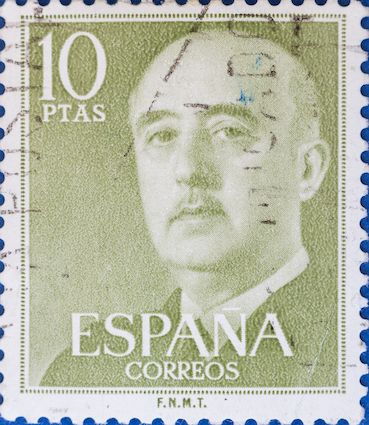
Primo de Rivera | Civil War | Franco
Spain remained neutral in the First World War, and it profited as a main supplier for many goods required in the rest of Europe. However, social unrest was everywhere. Then, in 1923 King Alfonso XIII endorsed the dictatorship of Primo de Rivera.
According to Eduardo González Calleja, after the economic collapse of 1929, the Spanish people pressured the king to remove Rivera. He replaced it with a dictablanda: a “soft” dictatorship. Finally, in 1931, Spain lost faith in its king. This forced Alfonso XIII to flee. Furthermore, Spain had a second republic that lasted between 1931 to 1936. But it was not meant: a military coup against the republican government in July 1936 caused the civil war.
Spain had struggled throughout its history, but nothing like this war. Historian Paul Preston states that both sides committed atrocities and wasted the lives of thousands of people. Picasso depicted the atrocities of the war in his famous painting Guernica. Unfortunately, the rebel nationalist won the war and established Francisco Franco as the leader of Spain. His dictatorship would last from 1939 until 1975. During this time, persecution and punishment continued in executions and concentration camps.
According to Stanley G. Payne, Franco tried to open up his political strategies to attempt to catch up with the rest of Europe. Since the 60s, one of his main strategies was opening up tourism and making money from many stereotypes that still haunt Spanish tourism to date. He also promoted new industries, which allowed some progress. However, this was short-lived and put to an end by the international oil and stagnation crises of the 1970s.
Democracy & the 21st Century (1975 – present)
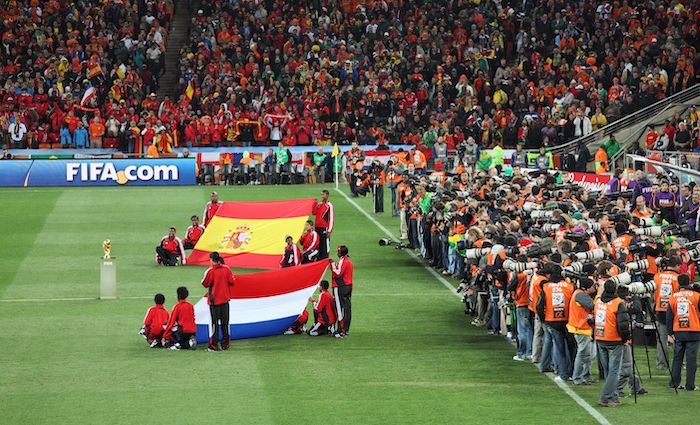
Democracy | Transition | 21st Century
On 20 November 1975, Franco died. Spain then headed into a new era of democracy with a coalition party and a constitutional monarchy that reinstated the Bourbons as the Spanish monarchy. In 1982 Spain had its first socialist government led by Felipe Gonzalez. This indicated that the period of transition from dictatorship to democracy was over.
Spain joined many European initiatives, including NATO and the EEC. In 1992 Barcelona hosted the Olympic Games for the first and only time to date in Spain. Spain is now a full member of the EU and one of the world leaders in organ transplants and donations.
Although still dealing with struggles, Spain is working to reclaim its place in the world as a country full of wonders and delightful culture. One of its most well-known achievements of the 21st century is the victory of the football world cup in 2010. Spain’s victory in the world cup came after years of La Liga being the epitome of modern football.
Clubs such as Real Madrid and Barcelona impacted football across the globe, making it a big deal for Spain. Finally, Spain achieved the complete ceasefire and breakdown of the terrorist cell ETA in 2018 that had been operative in the country since 1958.
That’s all for our rapid tour through the ages in Spain! I think this calls for a beer and some tapas!
